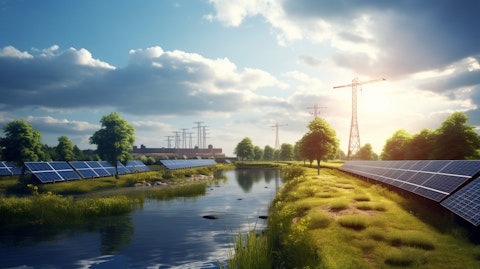In this article, we will look into the 20 countries with the highest renewable energy consumption in the world. If you want to skip our detailed analysis, you can go directly to the 5 Countries with the Highest Renewable Energy Consumption in the World.
According to the International Energy Agency (IEA), global renewable energy consumption has grown faster compared to global energy generation. In 2020, global renewable energy consumption increased from 11.4% in 2019 to 12.5%, excluding the traditional use of biomass. In 2022, the total renewable energy consumption was 45.18 Exajoules. Asia Pacific had the highest consumption of 20.24 Exajoules representing a share of nearly 45% of the total renewable energy consumption in the world, followed by America with a share of 28.7%.
Global Renewable Energy Capacity
According to a report by the International Renewable Energy Agency (IRENA), the global renewables deployment reached a new record, achieving a total capacity of 3,870 gigawatts. In 2023, the renewables represented 86% of the total capacity additions globally. However, due to the uneven distribution of its growth, renewable deployment is far from reaching its capacity target of 11 terawatts by 2023. You can also look at the countries with the highest renewable energy generation per capita.
2023 witnessed the largest increase in renewable energy capacity, with an addition of 473 gigawatts. This represents an increase of 13.9% in the global renewable power capacity. The growth can be attributed to the significant rise in solar and wind power deployments. Asia led the expansion with a 69% share in the total renewable capacity additions. China’s capacity grew by 63%, attaining 297.6 gigawatts. Solar energy continues to dominate the global renewable energy capacity, accounting for 73% of the renewable energy expansion, followed by wind energy.
On the other hand, Africa only saw a growth of 4.6%. In the European Union, improved focus on policy and increased energy security concerns became the key drivers of the growth of renewables in the region. Other regions including the Middle East and Oceania saw an increase of 16.6% and 9.4% in 2023. The G7 countries witnessed an increase of 7.6%, compared to 2022. The total capacity of renewable energy of the G20 nations reached 3,084 gigawatts in 2023.
The Biden administration is leveraging the federal land to reach its decarbonization goal by 2035. On April 11, it announced that the US has exceeded its renewable energy goal for public lands, by permitting over 25 gigawatts of clean energy projects by 2025. The administration also finalized a plan to cut project costs for wind and solar energy on federal lands.
On April 18, Reuters reported that wind farms in China generated more than 100 terawatt hours of electricity in March, recording the highest monthly total by one country, citing the data from energy think tank Ember. This represents a 25% year-over-year increase, extending China’s position as the largest renewable energy producer in the world. Its total output in March was twice the generation in the US. You can check out the states that produce the most renewable energy in the US.
Role of Renewable Energy Corporations
Iberdrola, S.A. (OTC:IBDRY), Ørsted A/S (OTC:DNNGY), and Canadian Solar Inc. (NASDAQ:CSIQ) are some of the corporations that provide renewable energy services around the world. Let’s discuss them in detail below.
Iberdrola, S.A. (OTC:IBDRY) is a renewable energy giant, engaged in the production, distribution, and supply of renewable energy in Spain, the UK, Mexico, and the US, among others. On April 25, the company announced that it has concluded its negotiations with Norges Bank Investment Management which manages the sovereign wealth fund of Norway, to increase its renewable energy deployment by 644 megawatts for their Iberian energy alliance. Now, the project has nearly 2,500 megawatts of renewable energy under development. Both companies started negotiations to double the amount of renewable energy, which was previously announced at 1,300 megawatts. Initially, the companies added 674 megawatts, and now an additional 644 MW has been agreed upon. The renewable portfolio of the joint project of Iberdrola, S.A. (OTC:IBDRY) and Norges Bank Investment Management, will have a total capacity to provide energy to over 400,000 households annually, avoiding 350,000 tonnes of CO2 each year.
Ørsted A/S (OTC:DNNGY) is one of the biggest wind energy companies in the world. It develops, owns, and operates offshore and onshore wind farms, energy storage facilities, and solar farms. On April 25, the company inaugurated one of the largest offshore wind farms in Asia Pacific, Greater Changhua 1 and 2a. The two wind farms are located in Taiwan, with a total installed capacity of 900 megawatts. This marks a huge milestone toward the completion of Ørsted A/S’s (OTC:DNNGY) offshore wind zone, Greater Changhua, which has a combined capacity of nearly 2.4 gigawatts. The two inaugurated farms alone can power nearly 1 million households in Taiwan, equivalent to reducing carbon dioxide emissions by 1.75 million tonnes per year.
Canadian Solar Inc. (NASDAQ:CSIQ) is a major solar and energy storage company, operating across Asia, Europe, and America. On April 15, the company announced that its utility-scale solar and energy storage development subsidiary, Recurrent Energy, has secured approximately $70 million of project funding from Banco do Nordeste do Brasil SA (BVMF:BNBR3) for its solar project in Brazil. Its 152-megawatt peak (MWp) project, Jaiba III, will be funded for its construction and operation phases, over 22 years. Currently in its construction phase, the project by Canadian Solar Inc. (NASDAQ:CSIQ) provides employment to approximately 900 people. It is expected to be operational in the last quarter of 2024.
Now that we have discussed the global renewable energy capacity and consumption patterns and talked about some of the major corporations in the renewable energy industry, let’s have a look at the 20 countries with the highest renewable energy consumption in the world.

A renewable energy source such as solar, wind or hydropower being installed in an industrial setting.
Methodology
To compile our list of the 20 countries with the highest renewable energy consumption in the world, we utilized the Statistical Review of World Energy by the International Energy Agency. Our list ranks the countries with the highest renewable energy consumption in the world in ascending order of their total renewable energy consumption in Exajoules, as of 2022. We have also listed the share of their renewable energy consumption as a percentage of the total primary energy consumption, as of 2022.
20 Countries with the Highest Renewable Energy Consumption in the World
20. Vietnam
Renewable Energy Consumption (2022): 0.33 Exajoules
Vietnam is ranked among the countries with the highest renewable energy consumption in the world. In 2022, the renewable energy consumption in the country reached 0.33 Exajoules.
19. Poland
Renewable Energy Consumption (2022): 0.39 Exajoules
Poland is ranked 19th on our list. In 2022, the country consumed 0.39 Exajoules of renewable energy. Total renewable energy consumption represents 9.4% of its primary energy consumption.
18. Mexico
Renewable Energy Consumption (2022): 0.45 Exajoules
Mexico’s renewable energy consumption was 0.45 Exajoules in 2022. It is the 18th country on our list with the highest renewable energy consumption in the world.
17. Netherlands
Renewable Energy Consumption (2022): 0.51 Exajoules
Ranked 17th on our list, the Netherlands is also one of the countries with the highest renewable energy generation per capita. In 2022, its renewable energy consumption was 0.51 Exajoules, representing 14.4% of its total energy consumption.
16. South Korea
Renewable Energy Consumption (2022): 0.52 Exajoules
South Korea is ranked 16th on our list of the countries with the highest renewable energy consumption in the world. The country had a renewable energy consumption of 0.52 Exajoules in 2022.
15. Sweden
Renewable Energy Consumption (2022): 0.56 Exajoules
Sweden’s renewable energy consumption represents 53.3% of its primary energy consumption. In 2022, Sweden consumed 0.56 Exajoules of renewable energy. It is ranked 15th on our list
14. Canada
Renewable Energy Consumption (2022): 0.59 Exajoules
Canada had a total renewable energy consumption of 0.59 Exajoules in 2022. Canada is also one of the top countries with the highest renewable energy generation per capita. It is ranked 14th on our list.
13. Turkey
Renewable Energy Consumption (2022): 0.69 Exajoules
Turkey ranks 13th on our list. In 2022, Turkey consumed 0.69 Exajoules of renewable energy, representing 18.8% of its primary energy consumption.
12. Australia
Renewable Energy Consumption (2022): 0.70 Exajoules
Australia is one of the top countries with the highest renewable energy consumption in the world. It consumed 0.70 Exajoules of renewable energy in 2022. It is ranked 12th on our list.
11. Indonesia
Renewable Energy Consumption (2022): 0.74 Exajoules
Indonesia had a renewable energy consumption of 0.74 Exajoules in 2022, which represents over 10% of its primary energy consumption. Indonesia is ranked 11th on our list of the countries with the highest renewable energy consumption.
10. Italy
Renewable Energy Consumption (2022): 0.76 Exajoules
In 2022, renewable energy consumption in Italy was 0.76 Exajoules. This represents 16.6% of its total primary energy consumption. Italy is among the top 10 countries with the highest renewable energy consumption in the world.
9. France
Renewable Energy Consumption (2022): 0.81 Exajoules
France is ranked 9th on our list. Its renewable energy consumption was 0.81 Exajoules in 2022. Its total Primary energy consumption comprised 14.6% renewable energy in 2022.
8. Spain
Renewable Energy Consumption (2022): 1.04 Exajoules
Spain is one of the top countries with the highest renewable energy consumption in the world. In 2022, it had a renewable energy consumption of 1.04 Exajoules. 21% of its primary energy consumption was from renewable energy sources.
7. United Kingdom
Renewable Energy Consumption (2022): 1.36 Exajoules
The United Kingdom is ranked 7th on our list. In 2022, the country consumed 1.36 Exajoules of renewable energy, which represents over 19% of its primary energy consumption.
6. Japan
Renewable Energy Consumption (2022): 1.53 Exajoules
Japan is ranked 6th on our list of the countries with the highest renewable energy consumption in the world. In 2022, the country consumed 1.53 Exajoules of renewable energy. The total renewable energy consumption of the country represents 12.1% of its total primary energy consumption.
Click to continue reading and see 5 Countries with the Highest Renewable Energy Consumption in the World.
Suggested Articles:
- 20 Countries with the Highest Share of Youth Not in Education, Employment, or Training (NEET)
- 20 States with the Highest Percentage of Mobile Homes in the US
- Republican Congress Members and Insiders are Buying These 10 Stocks
Disclosure: None. 20 Countries with the Highest Renewable Energy Consumption in the World is published on Insider Monkey.





